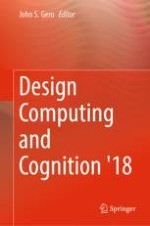2019 | OriginalPaper | Chapter
Demystifying the Creative Qualities of Evolving Actions in Design Reasoning Processes
Author : Tamir El-Khouly
Published in: Design Computing and Cognition '18
Publisher: Springer International Publishing
Activate our intelligent search to find suitable subject content or patents.
Select sections of text to find matching patents with Artificial Intelligence. powered by
Select sections of text to find additional relevant content using AI-assisted search. powered by
